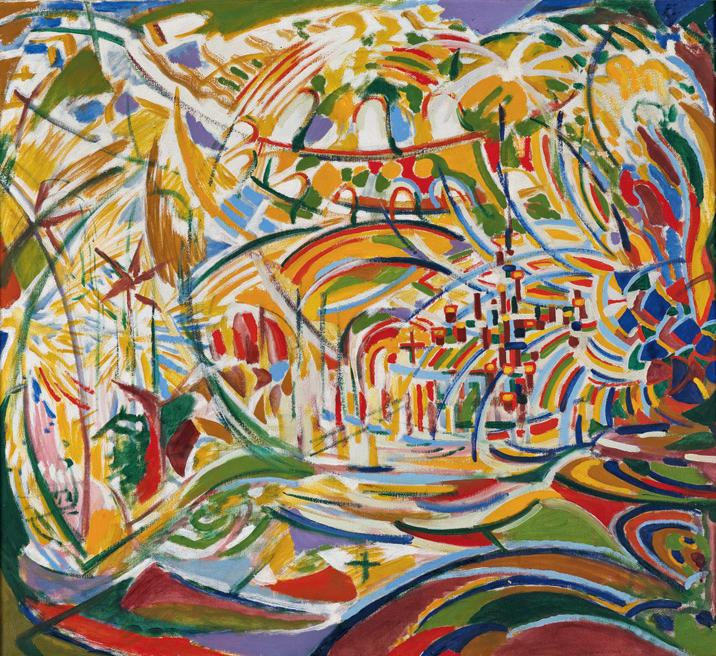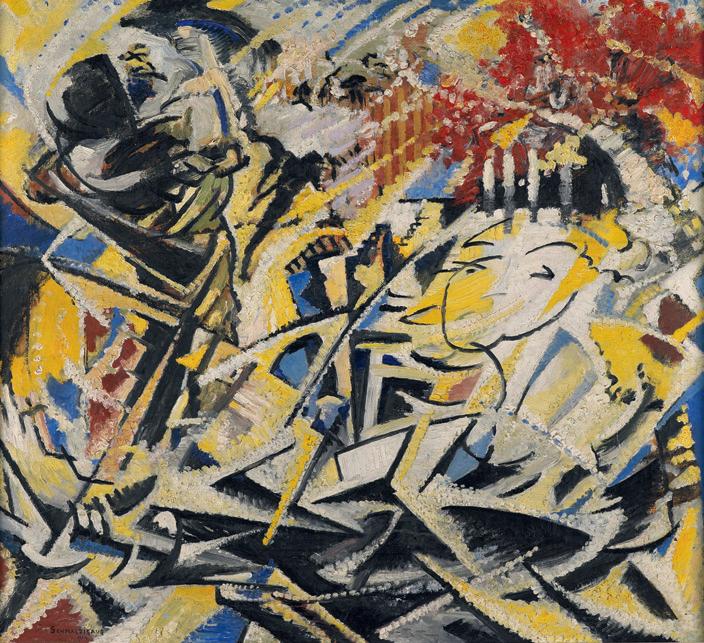


Word of Thanks
Luk Lemmens
KMSKA chairman
Carmen Willems
KMSKA managing director
Introduction The Rediscovery of a Top Talent
Adriaan Gonnissen
Curator modern art
KMSKA
Jules Schmalzigaug (1882–1917) and the KMSKA The History of a Colourful Collection
A Brief Outline of a Modern Master’s Life and Work
Adriaan Gonnissen
Phase 1 – 1928
Donation by Walter Malgaud
Phase 2 – 2015
Purchase of
Works on Paper
Phase 3 – 2018
Bequest from Mrs Gilberte Ghesquière
Phase 4 – 2020–2022
The Flemish Masterpieces Council and the Acquisition of the First Abstract Oil
Painting in Belgian Art History
Phase 5 – 2022
Gift by Gallery
Ronny Van de Velde
A New Phase
Schmalzigaug’s Ensemble of Six Paintings
Free Futurist International Exhibition at Galleria Futurista of Giuseppe Sprovieri, Rome, 1914
Endnotes Extended Captions Colophon

FIG. 1
Jules Schmalzigaug, Impression of Café Florian, 1914, black chalk, crayon, watercolour and gouache on paper, 31.7 × 39.3 cm, private collection
FIG. 2
Letter from Schmalzigaug to his parents with a sketch of a ‘flying machine’, Paris, 20 December 1911, Royal Museum of Fine Arts Antwerp – Flemish Community Collection, gift Gallery Ronny Van de Velde, 2022

‘Singing red’
In the early 1900s, Jules Schmalzigaug (1882–1917), an Antwerp painter with German roots, lost his heart to the bustling city life in metropolises such as Paris, Rome and Venice. It was in the mythical northern Italian city on the water that he became infatuated with the shimmering light and the views of the city’s many churches and basiliche, the Doge’s Palace and piazze, and the lagoon and its gondolas. He frequented the city’s dance halls and caffè concerti. He also witnessed the heated artist debates between more conservative ‘passéists’ and progressive Futurists first-hand at the famous caffè Florian in legendary St Mark’s Square. [Fig. 1] Rarely was the clash between the old and the new more exciting than in those heady early years of the 20th century.1
Schmalzigaug had also increasingly come to believe in the visual Modernism of the Futurists. He had also noticed the acceleration of modern life, technology and industry, and socio-economic upheavals, which these avant-gardists embraced wholeheartedly. In 1911, he wrote to his parents from Paris about his visit to the ‘flying machines’ during the Salon de l’aéronautique: ‘There are booths with machines that rival each other in perfection and are of admirable purity. This is infinitely more interesting than a salon of paintings where the rule of thumb is that a few artists show serious work but many des croûtes (rubbish).’2 [Fig. 2–3]
Two months later, again in the French capital, Schmalzigaug was blown away even more by his visit to the Futurists’ exhibition at the Bernheim-Jeune gallery. Triggered by what he saw, he wrote that he sensed that he was witnessing innovation on some level, but ‘I did not yet understand it.’3 It would take until early 1914 before he dared to nail his colours to the mast in a letter to Umberto Boccioni, one of the undisputed leaders of the Futurist movement. He asserted confidently that ‘une discipline neuve pour l’étude de la couleur’ (‘a new discipline for the study of colour’) would punctuate his own Modernist adventure, stating that he intended to compose Futuristic paintings as a great ‘optical polyphony’ of pigments. He referred more specifically to the ‘rouge qui chante’ (‘singing red’): the lush vermilion that sings, as in the iconic billowing red cloak in the foreground of Peter Paul Rubens’s altarpiece The Adoration of the Magi (1624), which is on display at the KMSKA.4 [Fig. 4–5]
Schmalzigaug thus seemingly had no problem connecting vivid memories of the historical museum in his hometown to Futuristic experiments in colour science and abstract avant-garde, larded with some theosophy and synaesthesia. Besides echoing Rubens’s opera in paint, the red that sings was also a reference to the sensory outpourings of Carlo Carrà, a Futurist who, in his manifesto La Peinture des Sons, Bruits, Rumeurs (1912), made the following sweeping statement: ‘The painting of sounds, noises and smells calls for: 1. Reds, rrrrreds, the rrrrrreddest rrrrrrreds that shouuuuuuut […] All the colours of speed, of joy, of carousings and fantastic carnivals, of fireworks, café chantants and music halls; all colours seen in movement, colours experienced in time and not in space.’5 [Fig. 6]
That same spring of 1914, Schmalzigaug’s style was beginning to be appreciated in Futurist circles thanks mainly to his participation in the high-profile Free International Futurist Exhibition at the Galleria Giuseppe Sprovieri in Rome.



Donation by Walter Malgaud
On 15 May 1928, the KMSKA’s chief curator, Arthur Henry Cornette, posted a letter addressed to his ‘cher ami’ (‘dear friend’) Walter Malgaud, a lawyer by profession and Schmalzigaug’s younger brother.7 (Shortly after the war, the originally German family had changed its name to the French-sounding Malgaud. Their not entirely unjustified fear of latent antipathy to a German-sounding name in Antwerp at the time would have played an essential role in this.) Cornette reported that ‘tes amis’ (‘your friends’) made the right decision in recommending a donation to the museum. ‘Because it is certain that they [Schmalzigaug’s paintings] constitute a very interesting effort in the history of our modern art.’
The letters from Malgaud to Cornette have yet to be found. Given the family ties, however, it is highly plausible that Malgaud’s advisers would have been friends of an art society called Kunst van Heden, which organised art exhibitions. From late 1907 or early 1908, Schmalzigaug had been affiliated with this society as an ‘assistant writer’, secretary and international networker.8 In the spring of 1923, Kunst van Heden also presented an extensive, posthumous survey of works by its former secretary at the annual Salon it traditionally organised in the Antwerp Festival Hall on the Meir. [Fig. 10] At the time, the wall space reserved for Schmalzigaug was filled mainly with the Futuristic canvases that his brother Walter was able to recover shortly after the war from the studio Jules had occupied in Venice from 1912 until 1914 and which he had been forced to leave on the spur of the moment due to the impending threat of war. In 1923, however, Belgian art criticism was (still) not quite ready for Schmalzigaug’s synthesis of the abstract, dynamic innovations in Italy’s urban centres. Some critics could be quite harsh: ‘sickly, a nightmare, and impossible dilettantism: nothing more but dynamic eccentricities which even the devil would have found hard to stomach […].’9
Those same art critics had nothing but praise, however, for the oeuvre of Rik Wouters, who, like Schmalzigaug, had died in exile in the Netherlands during the war and who was honoured with a retrospective at the same 1923 Salon. This penchant for Wouters in Antwerp, Flanders and Belgium was one of the lasting effects of the successful Salon that Kunst van Heden had organised in 1914. By then, Wouters’s status as a rising star of Belgian Modernism was already confirmed. Many of his works were on display, alongside comprehensive surveys of the oeuvre of Kempen painter Jakob Smits and Vincent van Gogh. The fact that Schmalzigaug had participated in the Free International Futurist Exhibition, a much talked-about event in avant-garde circles in Rome that same year, went completely unnoticed in Belgium.10 During their short careers, both artists had given a remarkably innovative emotional meaning and visual function to colour (and light). However, the domestic bliss of Wouters’s work was deemed lovelier and figurative, thus garnering acceptance more easily in his home country. The development of a more modern style of painting in the village of Watermael or Boitsfort, like Wouters did, curried more favour with Belgian critics than the more radical variant that had its origins in the cosmopolitan cities of Venice and Rome.
In 1913, Schmalzigaug set aside one of his painted impressions of the Rialto Bridge in Venice and some other canvases for the 1914 Kunst van Heden Salon. The artist never pursued this option, however, because he wondered whether a coming out in Flanders might negatively affect his growing rapprochement with Futurism.11 Ultimately, he had the following to say on the subject in a letter to Boccioni, one of his Futuristic counterparts in Italy: ‘I only have one word for this contemporary Belgian art, the Word SHIT. […] That is why I chose to go into exile, and well before I had the pleasure of encountering you and your friends, I had already chosen your fledgling nation of Italy as my elective home. Here I can breathe.’12








Jules Schmalzigaug, Composition, (1915–1916), pencil, watercolour and gouache on paper, 410 × 540 mm
Jules Schmalzigaug, Clown (Head), (1914–1915), coloured pencil and gouache on paper, 245 × 172 mm






Jules Schmalzigaug, Military Man, (1915–1917), Conté pencil on paper, 121 × 83 mm
Jules Schmalzigaug, Seated Woman, (1915–1917), Conté pencil on paper, 67 × 96 mm
Jules Schmalzigaug, Military Man, (1915–1917), Conté pencil on paper, 124 × 87 mm
Jules Schmalzigaug, Seated Woman, (1915–1917), Conté pencil on paper, 97 × 63 mm


Jules Schmalzigaug, Dynamic Sensation of the Dance (Night Bar Interior), 1913, oil on canvas, 102 × 130 cm, The Phoebus Foundation, Antwerp
Jules Schmalzigaug, Development of a Rhythm: Electric Light + 2 Dancers, 1914, oil on canvas, 81 × 65 cm, FIBAC, Berchem



